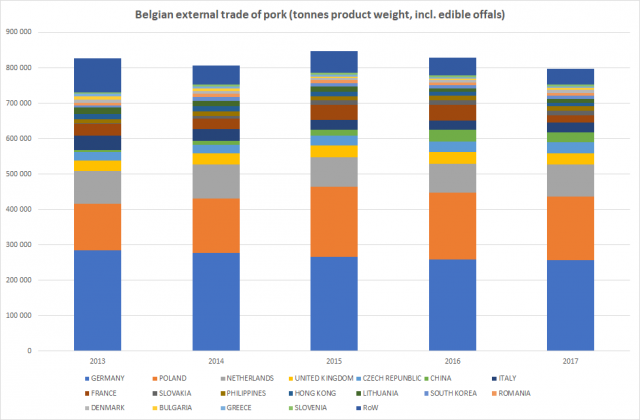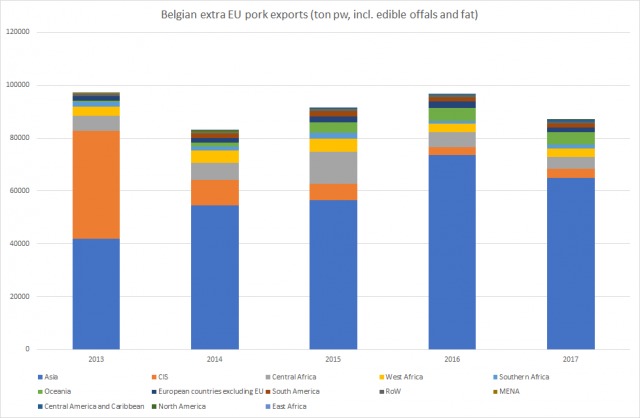In 2017, Belgium exported a total of 797,017 tonnes of pork. This is 3.9% less than in 2016. In the long term (compared to 5 and 10 years ago) exports remained stable. The vast majority of Belgian pork, 89%, goes to countries within the European Union. Exports within the Union fell by 3%, those to third countries by 10.4%.
European Union
Top 3 is maintained
As in 2016, the following countries remain the most important export markets for Belgian pork:
1. Germany: 257,137 tonnes of pw (2017); stable exports compared to 2016.
2. Poland: 178,453 tonnes pw (2017); - 5.1% compared to 2016 but + 9.9% (CAGR) as from 2012 and + 32.7% (CAGR) as from 2007.
3. The Netherlands: 90,621 tonnes of pw (2017); + 11.7% compared to 2016.

Exports to the UK
As you can see in the above chart, the United Kingdom is Belgium’s fourth most important export destination for pork. The pork exports amounted to 32,277 tonnes pw in 2017 or -4.9% compared to the year before. In the long term Belgian pork exports to the UK are relatively stable: +2.6% (CAGR 17/12); - 4.1% (CAGR 17/07). Up until 2010 the UK was an important market for Belgian pork carcasses and the exports amounted to 33,018 tonnes pw or 61% of the total pork exports. In 2011 the exports dropped by 46% and amounted to 7,041 tonnes pw in 2017. However, the exports of meat are growing for the last 5 years and amounted to 22,160 tonnes pw last year. Edible offal and pig fat are less important export products. Their share amounted to respectively 6.4% (2,079 tonnes) and 3% (997 tonnes).
Changes in the European market
France, which was our fourth export market in 2016, has now dropped back to the 7th place. Exports fell from 43,075 tonnes pw in 2016 to 20,385 tonnes pw in 2017, a decrease of no less than 52.7%. Also compared to 5 and 10 years ago, exports fell by 7.8% (CAGR) and 6.6% (CAGR) respectively.
The Czech Republic, on the other hand, is becoming an increasingly important export market when we look at the export figures. Exports to this country have been growing for several years and reached a peak in 2017 with 31,448 tonnes of pw. In the short, medium and long term, export figures are on the rise: + 7.3% compared to 2016; + 10.1% (CAGR) as from 2012 and + 26% (CAGR) as from 2007.
The export to Lithuania and Romania also rose sharply in 2017. In 2017 Belgium exported 10,488 tonnes of pork to Lithuania, an increase of 15.2% compared to 2016. In Romania, 7,818 tonnes of pork were exported, an increase of 32.9% compared to 2016. Compared with 10 years however, exports to Romania have remained almost stable.

Asia
Exports of Belgian pork to East and Southeast Asia fell by 11.7% in 2017 compared to 2016. The biggest drop-outs are Vietnam, Malaysia and Singapore. Compared to 5 years ago, the export figures are a lot more positive. For example, the compound annual growth of exports to Vietnam is 77.7% as from 2012, for China it is 57.2% and for the Philippines 10.2%. South Korea remains stable and Japan declines slightly with a compound annual growth of -5% as from 2012.

Elsewhere in the world
Exports to the Commonwealth of Independent States (CIS) rose in 2017 by 14.5% to 3,448 tonnes pw. This is mainly due to a strong increase in exports to Azerbaijan and Moldova.
Exports to Central Africa in 2017 amounted to 4,523 tonnes pw or a decrease of 21.5% compared to 2016. A striking fall is the Democratic Republic of Congo, for example. In the short, medium and long term, we see that the export to Angola and Congo is doing well. It is primarily about offal.
In contrast, West African countries import more Belgian pork, namely 3,247 tonnes pw or 7.5% more than in 2016. Mainly due to an increasing demand in Ghana and Ivory Coast. These countries also mainly import offal.
Both exports to Australia and New Zealand fell by 7.8% in 2017 to 4,631 tonnes pw. However, compared to 5 years ago, the growth is spectacular, namely 149.8% (CAGR) for both countries.